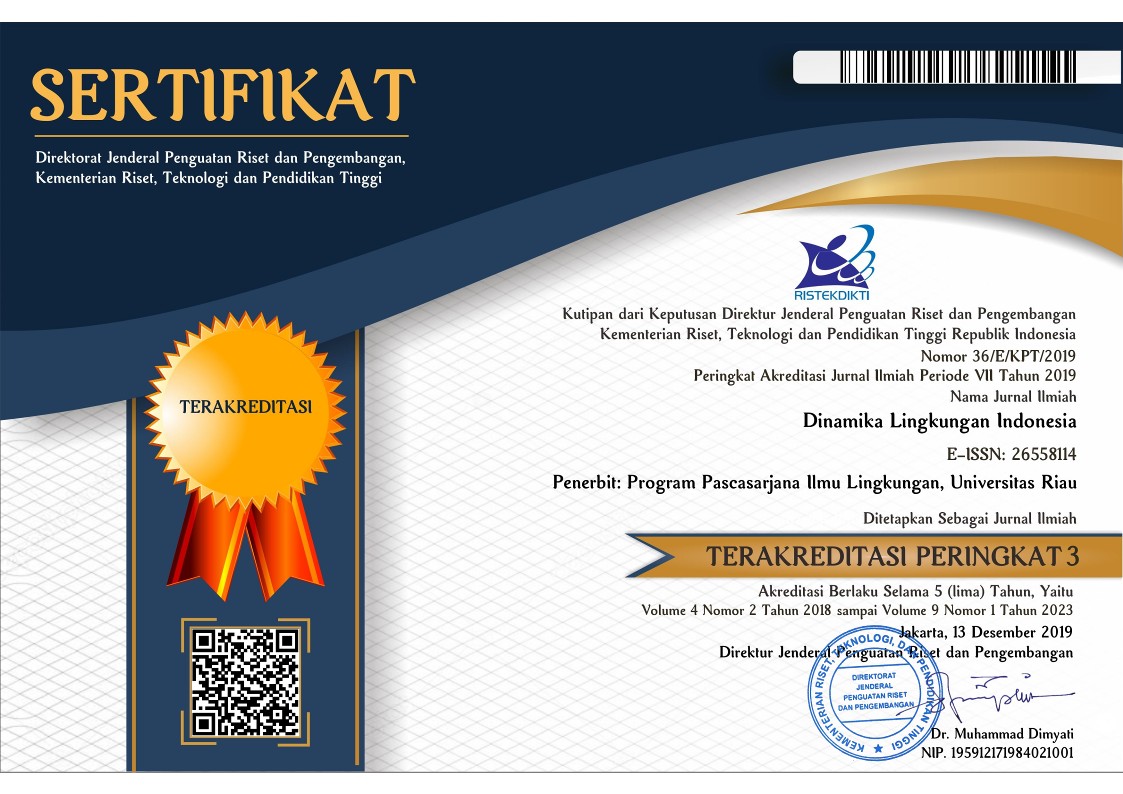Analisis Limbah Medis Layanan Kesehatan Gigi Mandiri dan Potensi Pencemarannya di Kota Pekanbaru
Abstract
Healthcare development contributing positive outcome on public health status, but on the other side, medical waste existence become a troublesome as long as increased medical healthcare quantity particularly private dental healthcare. The amount of improperly managed medical wastes become accumulated and causing widespread pollution. The roblem of this study is improperly managed medical waste getting more increased causing widespread pollution. Even though 15-25 % of this contamination were categorized as hazardous waste, the risk is much greater. The purpose of this study was to analyze the number and types of private healthcare medical waste and its potential pollution. This study used descriptive qualitative with interviews and observations after conducting a survey of calculating the number and identification of medical waste types produced by private dental healthcare in Pekanbaru. The results showed 69% of infectious, 27% toxic, and 4% radioactive wastes. The presence of this medical waste has the potential to polluting water and soil environment, triggering health problems for health workers and high risk communities, and disrupting social and economic aspects of residents at nearby waste disposal. It is recommended that private dental healthcare to reduce generated medical wastes and to use safe and eco-friendly materials and tools for dental and oral care.
Keywords
Full Text:
PDFReferences
Abdel fatah,2008. Environmental Implications of Recycling and Recycled Products.
Baghele, O., Baghele, M., Deshpande, A., Deshpande, J. and Phadke, S. 2013 ‘A simplified model for biomedical waste management in dental practices - A pilot project at Thane, India, European Journal of General Dentistry. 235.
Goya, N., Sunil, M. K., Trivedi, A. and Gupta, S. 2016. The Environmental Impact of Dentistry by waste management. International Journal of Oral and Maxillofacial Disease Vol 1. No 2: 8–11.
Haroon Rashid, Zeeshan Sheikh, Fahim Vohra (2015). Allergic Effects Of The Residual Monomer Used In Denture Base Acrylic Resins European Journal Of Dental 2015 9 (4) : 614-619.
Kooviland A, Gholami F, Borujeni (2014). Investigation of The Characteristics and Management of Dental Waste in Urmia, Irac. Journal Mater Cycle Waste Management.
Irhamni, Setiaty Pandia, Edison Purba, Wirsal Hasan (2017). Kandungan Logam Berat pada Air Lindi Tempat Pembuangan Akhir (TPA) Sampah Kota Banda Aceh. Prosiding Seminar Nasional Pascasarjana (SNP) Unsyiah 2017, April 13, 2017, Banda Aceh, Indonesia.
Margot Hiltz (2007). The Environment impact of Dentistr. JCDA .www.cda-adc.ca/jcda • Vol. 73, No. 1.
Rebecca Allen (2016). The Safe Disposal Of Gypsum Waste Within The Dental Profession. Dental Review News 5 Januari 2016. Manchester United Kingdom.
Sonia B, Yuyun I (2016). Survei awal Pemahaman pada Kelompok Profesi Terhadap Dampak Penggunaan Dental Amalgam di Indonesia .Bali Focus Foundation.
Triadi PT (2011). Pencemaran Logam Berat Merkuri (Hg) Pada Airtanah. Jurnal TEKNIK Vol. 32 No. 1ISSN 0852-1697 Wulandari CY, Sukandar. (2011). Timbulan dan Komposisi Limbah Medis Pelayanan Kesehatan Gigi Umum Perorangan (Studi Kasus Kota Bandung).
DOI: http://dx.doi.org/10.31258/dli.6.1.p.14-19
Refbacks
- There are currently no refbacks.





